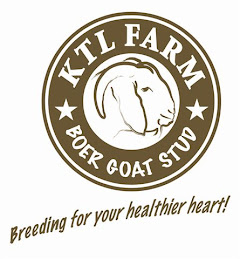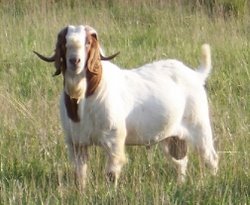| (An excerpt from the book, Raising Meat Goats for Profit by Gail Bowman.) |
| Boer goats come to us from South Africa. The earliest recorded goats in Africa were brought to western Uganda by the Black Nations as early as AD 1200. Boer goats were developed in Southern Africa by breeding these ‘indigenous’ stock to European imports. The point, of course, was to have a hardy, very adaptable, meat animal that could survive the varied conditions of the African landscape while still maintaining a high birth rate, high survival rate, and a marketable meat carcass. |
| Researchers have had little luck pinning down an exact line of decent for the modern Boer goat. Early breeders include such varied and inexact groups as the "Southern Bantu" people, the Namaqua Hottentots, the Indians (from India) and Europeans. "Boer" means "farm" in Dutch.i |
| By the beginning of the 20th century, however, the breed was becoming much more distinct as the ranchers in the Eastern Cape Province of Africa started breeding for a definite meat type goat with many of the Boer characteristics that we recognize today. The late Mr T. B. Jordaan of Buffelsfontein, Somerset East, stated in the first journal of the South African Boer Goat Breeders’ Association published in 1959, that his father, Mr. W. G. Jordaan, bought some goats from Mrs. Van de Venter of Somerset East. These goats were short haired and had light red heads. At the same time he bought a very large dapple-colored male goat from Mr. I. B. van Heerden of Kaalplass, Cradock. From these goats, some of the earliest breeding stock was developed.ii |
| On July 4th, 1959, breeding and selection became regulated by the foundation of the Boer Goat Breeder's Association (of South Africa). In the past forty years, the breed standards of this association have helped to guide and mold the Boer goat into an "improved" breed emphasizing good overall conformation, a compact and well muscled body structure, high growth and fertility rates, short white hair, darkly pigmented skin, and red markings on the head and shoulders. In 1970 the Boer goat was incorporated into the National Mutton Sheep and Goat Performance Testing Scheme, which makes the Boer goat the only known goat breed involved in a performance test for meat production.iii |
| |
| In 1977, the Boer goat was imported into Germany. In 1987 Lancorp Corporation Ltd. imported Boers into New Zealand, and in 1988 they were imported into Australia. The first Boer embryos to reach the North American Continent were implanted into recipient does at Olds College in Canada. These goats stayed in quarantine until April 1993, when Boers were released into the United States and Canada. In New Zealand, three main parties were involved in the importation of South African Boer Goats: Lancorp Corporation Ltd., Embryotech Corporation, and African Goat Flock Co. In Australia the major importer was Australian Breeding Management Pty Ltd. 2 |
Since 1987 the Boer goat has been imported by New Zealand, Canada, Germany, Mexico, Australia, Indonesia, England, India, France, Malaysia, Denmark, British West Indies, Netherland Antilles, and virtually every state in the United States. |
Boer Goats: What and Why?
| |
| I raise Boer Goats in the Northwestern United States. Why? Why not raise cattle or sheep like most people? Hopefully, this article will answer those questions and many more that you may have about the fastest growing agricultural industry in the United States: Boer Goats! |
| First of all, what is a Boer Goat? Boer goats are large framed animals resembling, in many ways, the Nubian goat. The most obvious difference is the size. A Boer is a large, double muscled animal. Boers are specifically meat goats. They can consistently produce more muscling in less time, and will pass this capability to their kids. Boers are to the meat goat industry what imported cattle were to the beef industry. Boers goats were developed in South Africa for their meat, hardiness and brush control abilities. |
| What do Boer goats look like? As I said before, they are large animals, generally white with a reddish brown head and (usually) a white blaze down the middle of the face. Solid red Boer goats are also becoming more and more popular. Mature weights between 200 and 350 pounds for males and 120 to 200 pounds for females are considered normal. They have long ears that should hang down along the sides of their faces. The leg bones and general bone structure of a Boer goat are bigger and thicker than in other kinds of goats. When you look at a Boer goat you should look for a deep, broad chest, good back, strong shoulders and heavy muscling in the rump. |
| Boers are hardy, adaptable and easy to handle. I use a simple three sided structure to give my goats shelter from the sun, wind and snow. However, my Boers often don't use it. They seem to be very happy lying out in the sun on 90 to 100 degree days (their skin is darkly pigmanted under the white fur to reduce the risk of sun burn). The Boers in my herd have also been known to sleep outside down to about 10 degrees, rather than curl up in the goat house with the rest of the herd. I have also noticed that Boers aren't as interested in jumping fences as dairy goats. I have found that any kind of mesh fencing or electric fence, at least 3 or 4 feet tall will confine my Boers. |
| There are many other kinds of animals that produce meat in the United States. Many that are widely accepted and that we are more accustomed to raising than Boer goats. So, why raise Boer goats? One reason is efficiency of feed and space. The accepted standard in the Northwest for raising cattle is one cow-calf pair per acre of good pasture. With goats, the equal comparison would be six does with two kids each per acre. Ten months after breeding, a cow is nursing a 75 pound calf. Ten months after breeding to a Boer buck, six dairy or spanish goats will have raised 12 kids (a goat's gestation period is 5 months), and the kids will have been sold. Boer cross kids reach a market weight of 50 to 90 pounds at about 5 months of age. (A weight gain of .5 pounds a day (or more) in cross bred kids is not considered unusual). If we use a market weight of 60 pounds, at $1 per pound, these 12 kids sold for $720. The same six does were then rebred 60 to 90 days after the kids were born and are now 60 days pregnant ten months after the first breeding! |
| At the end of 18 months, the cow should be pregnant again, and her calf is ready to be sold for $325 (in current market conditions here in the Northwest). The six does have kidded again with another 12 kids (plus the does would be pregnant again) who are now 5 months old and ready to be sold for another $720. Feed cost comparisons between one cow and six goats would vary greatly, depending on the time of year, type of pasture and area of the country. It may cost a little more to feed the six does than the single cow, but the difference in the sales ($1440 - $325 = $1115 more gross sales) certainly makes up the difference. Plus you don't need expensive squeeze chutes, and it is easier to own a buck than a bull or to artificially inseminate a doe than a cow. |
| If you have 10 acres, you can easily raise 60 goats or ten head of cattle. Goats, especially Boers or Boer crosses, can survive, even prosper, on poor pasture and brush that would not support cattle. Many breeders find the fact that goats will eat berry bushes, russian olive, elm or cottonwood trees, ragwort, gorse, dock, amerauthis and other weeds, to be an important factor when deciding to raise goats. Some ranchers also find it good pasture management to run goats on the pasture after their cows to clean up the weeds. |
| Goat meat has a lower fat content than either lamb or beef and is eaten by over 80% of the world's population. Already, the popularity of goat meat in the United Sates is rising dramatically. One reason might be the improved flavor that the Boer adds to the meat. We have found that adding just 50% Boer bloodlines to our goat meat produces a very mild and tender, light red meat that readily takes on any seasoning we have tried. Breeders have reported that their kids are ready for market sooner, and their customers will actually pay them a premium for their meat goats if they add Boer blood to their herd! |
| Many people raise milk goats because they love goats. But it has been said that it takes less time to feed 100 goats than to milk 10! More and more people, like myself, want to buy a small piece of land and raise a few animals, but not an animal that is going to run over me or break my foot if it steps on me. What do you do if you don't especially want to milk, can't stand the smell of pigs, the mess of rabbits, or the stupidity of sheep? Thousands of people have found meat goats to be the perfect answer. |
| How do you get started? There are as many answers to that question as there are breeders. A meat herd should have a Boer or Boer-cross buck or two, and as many dairy, spanish or mixed-breed does as you want to raise. I definitely recommend buying your goats from reputable breeders rather than the stock yard auctions. Most people find that the loss from diseases brought home from the stock yards more than make up for the lower prices. Your Boer or Boer cross buck should be papered. Blood lines may not be important to your meat herd, but a registration paper is your only way of being reasonably sure that you received what you paid for, or maintaining the resale value of your buck! |
| If you just want to raise a few breeding animals, rather than a large meat herd, my best advice is to know the breeder you are buying from! Never buy breeding stock from a truck that is just passing through! Always have a pedigree or pedigree application in your hand when you leave the ranch with your animal. Ask about disease control programs. Take a look at the condition of the whole herd, ask to see related animals that have reached maturity (if you are buying kids), and make sure that your breeder intends to guarantee your purchase should the animal turn out to be a non-breeder (a very rare situation in goats). The vast majority of breeders are in the business of raising animals because they love the animals, and are truely trying to do a great job. Find one of these to buy your breeding stock from! Boer goats are fun to raise and can be very loving animals. Enjoy |

